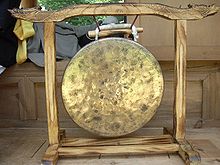Jing (instrument): Difference between revisions
Appearance
Content deleted Content added
m Romanization |
No edit summary |
||
| Line 6: | Line 6: | ||
|mr=ching |
|mr=ching |
||
|}} |
|}} |
||
The '''''jing''''' is a large [[gong]] used in traditional Korean music, particularly in ''[[samul nori]]'', ''[[pungmul]]'', and ''[[daechwita]]''. It is struck with a large, padded stick and drops in pitch slightly when struck firmly. |
The '''''jing''''' is a large [[gong]] used in traditional Korean music, particularly in ''[[samul nori]]'', ''[[pungmul]]'', and ''[[daechwita]]''. Usually made from brass, it is struck by a hammer that is layered with soft cloth to smoothen the texture of the sound produced. It is typically played at the onset of ceremonies and special occasions. It is struck with a large, padded stick and drops in pitch slightly when struck firmly. |
||
Its name was originally pronounced ''jeong'' ([[wikt:정|정]], deriving from the [[Sino-Korean]] [[wikt:鉦|鉦]]). |
Its name was originally pronounced ''jeong'' ([[wikt:정|정]], deriving from the [[Sino-Korean]] [[wikt:鉦|鉦]]). |
||
Revision as of 22:41, 18 June 2010
| Jing | |
 | |
| Korean name | |
|---|---|
| Hangul | |
| Hanja | |
| Revised Romanization | jing |
| McCune–Reischauer | ching |
The jing is a large gong used in traditional Korean music, particularly in samul nori, pungmul, and daechwita. Usually made from brass, it is struck by a hammer that is layered with soft cloth to smoothen the texture of the sound produced. It is typically played at the onset of ceremonies and special occasions. It is struck with a large, padded stick and drops in pitch slightly when struck firmly.
Its name was originally pronounced jeong (정, deriving from the Sino-Korean 鉦).
See also
